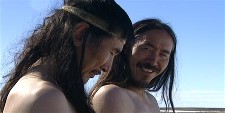 I had to talk Murray into coming with me to see “Atanarjuat (The Fast Runner),” a film about good and survival vs. evil and death among traditional Inuit, at International House last night.
I had to talk Murray into coming with me to see “Atanarjuat (The Fast Runner),” a film about good and survival vs. evil and death among traditional Inuit, at International House last night.
“Atanarjuat” is one of the film series that is part of the Fabric Workshop and Museum’s “Experiments with Truth” international survey of contemporary film making, which focuses on documentary in modern art film-making.
I can quibble my way into high dudgeon, since “Atanarjuat” is neither a documentary nor an art-gallery kind of film.
But whatever category it might belong in, it is certainly wonderful, and if you ever get a chance to see it, go. Even Murray, who’s a dedicated follower of pop culture (I had to promise him we’d leave if the film turned out to be bad-arty), was won over and dazzled by this film, which has in it extraordinary arctic locale, an exotic way of life, mythic story telling, love, sex, jealousy, murder, mayhem, and threats to the entire social order.
In short, it’s the north country’s own Greek drama, with evil deeds throwing a community out of balance across generations and corrective deeds righting the wrong and healing the community. Without healing and restoration of communal values of cooperation, it is clear that these people could not survive in such a harsh climate.
The film, which retells an oral tale handed down through Inuit generations, is a sort of Rain King myth–with a spiritual resurrection and ensuing rescue. At the beginning, keeping track of who is who and who did what to whom was a little puzzling. But after that, we were gripped by the tale as well as by the scenery, the clothing required for survival, the relationships, the method of building igloos, the food customs and rituals, etc., etc.
In contrast to Hollywood and cable TV licentiousness, the movie served as a great reminder that sexual attraction doesn’t require T&A to start the juices flowing, although spring does help. Just moving with all those layers of furs must be exhausting, but burrowing through to find the body beneath is its own sort of turn-on.
Another astonishing moment was a ritual punch-down before the community, gathered in an igloo, between the two antagonists. Nothing like fighting as we know it, with rules for how each blow is cast, it’s a lesson in cultural differences.
The outtakes at the end of the movie showed some of the creative film-making techniques used to track the actors as they moved across the ice and snow.
This movie, which is nearly 3 hours long (172 minutes) held my interest–and still holds my interest as I ruminate over the dramatic images and the story–in ways that 2-minute gallery videos and traditional documentary never could. I give it five stars out of five, and a Better-Than-Hollywood vote for being nothing like the navel-gazing and shallowness that permeates our American movie culture.
See the FWM website for other films and discussions. By the way, following Isaac Julien’s “Frantz Fanon: Black Skin/White Mask” on Wednesday, the artist will take part in the post-screening discussion, this according to the FWM Director of Public Programs and Exhibitions Doug Bohr in his intro to “Atanarjuat.”









